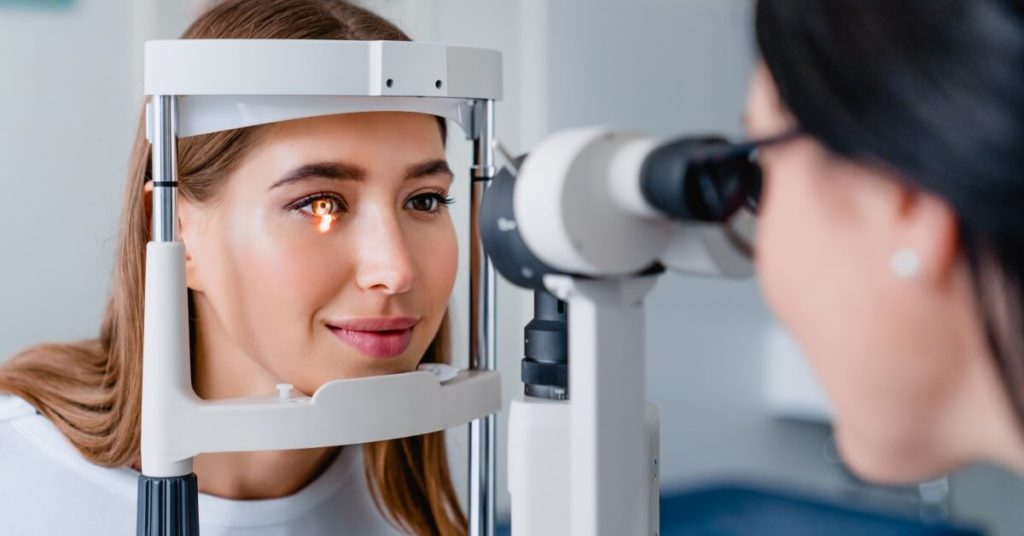
Overview
You notice a bit of fuzziness in your vision while looking at your laptop screen at work but think nothing of it. It could be just eye fatigue, but then you notice it every day and at different times. Before you know it, the same fuzziness happens when you look at your phone. Could it be time to get your eyes checked?
Many Americans experience this exact scenario, which finally spurs them to get an eye exam. But even though the vast majority of us agree that vision care is an integral part of health care, only about 50 percent of the general population gets regular eye exams.[1]
Eye health cannot be taken for granted, mainly because it is subject to time-related degeneration that dramatically impacts our quality of life.
Moreover, there are times when an eye test takes on additional importance and, in some cases – urgency. Sit tight because we’re going to review five signs you should get your vision checked.
Five Signs You Should Get Your Vision Tested
- You Can’t Recall When You Had Your Last Eye Exam
Early diagnosis and treatment of any health issue are critical to a better chance of full recovery. Your eyes are no different. Many eye diseases like glaucoma and macular degeneration have no immediate symptoms and can go unnoticed for a long time. With a full eye exam, anything that requires treatment may be caught in time, and depending on the results, you will be advised how long you can go before the next check-up – usually every one to two years.
- You Are at High Risk for Eye Diseases
Suppose you have a family history of cataracts or have diabetes which puts you at higher risk of glaucoma or diabetic retinopathy.[2] In that case, it is highly advisable to get regular eye exams as these conditions can cause blindness if they are unaddressed over time.
- Worsening Vision
It can take a long time for someone to understand and accept that something with their vision needs intervention. Denial can be strong, especially regarding presbyopia – a common age-related vision disorder with a progressive inability to focus on close objects.[3] However, worsening vision can also be a sign of refractive errors[4] and other health concerns, so don’t put off that eye doctor visit when things are going fuzzy.
- Red, Itchy, and Dry or Watery Eyes
Although it may be just a case of known allergies actin01g up, these could also be signs of dry eye syndrome[5] or even inflammation of the eyelids, known as blepharitis.[6] There are effective treatments for both conditions, but they must be properly diagnosed first.
- Light Sensitivity
Light sensitivity, coupled with a terrible headache, can be due to migraine. Even without any pain, it can indicate a serious health issue, such as a traumatic brain injury or an impairment of the optic pathway,[7] and should be addressed as soon as possible.
What’s the Takeaway?
Eye health can be taken for granted. However, regular check-ups for our eyes – one of the essential parts of the human anatomy – are only done by about half of the population of the U.S.
Get regular eye exams and know the signs when conditions become more urgent. Don’t let a preventable eye problem rob you of your vision.
References:
- Wagner, L. D., & Rein, D. B. (2013). Attributes associated with eye care use in the United States: a meta-analysis. Ophthalmology, 120(7), 1497–1501. https://doi.org/10.1016/j.ophtha.2012.12.030
- Albilali, A., & Dilli, E. (2018). Photophobia: When Light Hurts, a Review. Current neurology and neuroscience reports, 18(9), 62. https://doi.org/10.1007/s11910-018-0864-0
- Katz, J. A., Karpecki, P. M., Dorca, A., Chiva-Razavi, S., Floyd, H., Barnes, E., Wuttke, M., & Donnenfeld, E. (2021). Presbyopia – A Review of Current Treatment Options and Emerging Therapies. Clinical ophthalmology (Auckland, N.Z.), 15, 2167–2178. https://doi.org/10.2147/OPTH.S259011
- Schiefer, U., Kraus, C., Baumbach, P., Ungewiß, J., & Michels, R. (2016). Refractive errors. Deutsches Arzteblatt international, 113(41), 693–702. https://doi.org/10.3238/arztebl.2016.0693
- Golden, M. I., Meyer, J. J., & Patel, B. C. (2022). Dry Eye Syndrome. In StatPearls. StatPearls Publishing.
- Eberhardt, M., & Rammohan, G. (2023). Blepharitis. In StatPearls. StatPearls Publishing.
- Katz, B. J., & Digre, K. B. (2016). Diagnosis, pathophysiology, and treatment of photophobia. Survey of ophthalmology, 61(4), 466–477. https://doi.org/10.1016/j.survophthal.2016.02.001


